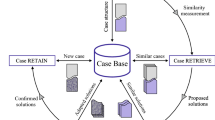Abstract
The process design of injection moulding involves the selection of the injection moulding machine, mould design, production scheduling, cost estimation, and determination of injection moulding parameters. Expert system approaches have been attempted to derive the process solution for injection moulding in the past few years. However, this approach has been found to be incapable of determining the injection moulding parameters owing to the difficulty in setting the moulding parameters. In addition, the existing expert systems for process design lack the proper architecture for organising a heterogeneous knowledge source. In this paper, the combination of a blackboard-based expert system and case-based reasoning approach is introduced to make up the deficiencies of the existing expert-system approach to the process design, from which a computational system for process design of injection moulding, named CSPD, was developed and described. CSPD first derives the process solution including the selection of injection moulding machine and mould base, tooling cost, and processing cost estimation, and production scheduling based on the blackboard-based expert-system approach. It is then followed by the determination of the injection moulding parameters based on the case-based reasoning approach and the previously derived partial solution.
Similar content being viewed by others
References
J. Farris and W.A. Knight, “Design for manufacture: expert processing sequence selection for early product design”,Annals CIRP,41(1), pp. 481–484, 1992.
A. R. Venkatachalam, J. M. Mellichamp and D. M. Miller, “Automating design for manufacturability through expert systems approach”,Concurrent Engineering: Contemporary Issues and Modern Design Tools, London, Chapman & Hall, 1993.
K. S. Chin and K. F. Pun, “Expert systems for concurrent engineering: an expert injection mould costing system”,Proceedings, International Conference on Data and Knowledge for Manufacturing Engineering, Hong Kong, pp. 174–179, 1994.
C. Poli and S. Rajagopalan, “Design for injection molding and die casting: a knowledge-based approach”,Computers in Engineering, ASME,1, pp. 53–59, 1991.
D. A. Clinquegrana, “Knowledge-based injection mold design automation”, DEng. thesis, University of Lowell, 1990.
J. A. Meckley, S. P. Mccarthy and C. Clinquegrana, “A knowledge-based computer optimization for three plate and hot runner mold designs”,SPE, Proceedings of ANTEC'92, pp. 2342–2343, 1992.
Y. J. Huh and S. G. Kim, “A knowledge based CAD system for concurrent product design in injection moulding”,International Journal of Computer Integrated Manufacturing,4(4), pp. 209–218, 1991.
H.P. Nii, “Blackboard system: part one”,AI Magazine, Summer, pp. 38–53, 1986.
H.P. Nii, “Blackboard system: part two”,AI Magazine, August, pp. 82–106, 1986.
S. Subramanyam, “Computer-aided simultaneous engineering for components manufactured in small and medium lot-sizes”, PhD thesis, University of Illinois at Urbana-Champaign, 1989.
R. E. Levitt, Y. Jin and C.L. Dym, “Knowledge based support for management of concurrent multidisciplinary design”,AI EDAM,5(2), pp. 77–95, 1991.
W. R. D. Wilson and J. Wang, “A multi-expert system for sheet metal part design”,Advances in Design Automation, vol. 1, DE-vol. 32-1, ASME, 1991.
H. Hanada and L. J. Leifer, “Intelligent design system for injection molded parts based on the process function analysis method”,Proceedings, NSF Engineering Design Research Conference, Amherts, MA, pp. 599–612, 1989.
G. Mullineux, “A blackboard structure for handling engineering design data”,Engineering with Computers,7, pp. 185–195, 1991.
R. C. Schank,Dynamic Memory: A Theory of Learning in Computers and People, Cambridge University Press, 1982.
C. Riesbeck and R. C. Schank,Inside Case-Based Reasoning, Lawrence Erlbaum, Hillsdale, NJ, 1989.
K. Hammond,Proceedings, Case Based Reasoning Workshop, Pensacola Beach, Florida, 31 May–2 June, 1989.
H. Wang, W. F. Lu and A. C. Li, “A framework for using case based reasoning in automated process planning”,Concurrent Engineering, PED-59, ASME, pp. 101–114, 1992.
M. L. Maher, B. Balachandran and D. M. Zhang,Case Based Reasoning in Design, Lawrence Erlbaum, Mahwah, NJ, 1995.
J. L. Kolodner,Case Based Reasoning, Morgan Kaufmann, San Mateo, CA, 1993.
P. Pu and M. Reschberger, “Case based assembly planning”,Proceedings, Case Based Reasoning Workshop, Washington, DC, pp. 245–254, 8–10 May 1991.
M. Adalier and C. Tstsoulis, “Redesigning for manufacturability using REINRED”,Applied Artificial Intelligence,6(3), pp. 285–302, 1992.
H. Zhang, “Selecting typical instances in instance-based learning”,Proceedings, The Ninth International Workshop of Machine Learning, San Mateo, CA, Morgan Kaufmann, pp. 470–79, 1992.
Author information
Authors and Affiliations
Rights and permissions
About this article
Cite this article
Kwong, C.K., Smith, G.F. A computational system for process design of injection moulding: Combining blackboard-based expert system and case-based reasoning approach. Int J Adv Manuf Technol 14, 239–246 (1998). https://doi.org/10.1007/BF01199878
Issue Date:
DOI: https://doi.org/10.1007/BF01199878




